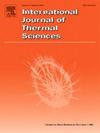Integrated liquid-cooled battery module with dual functions: Thermal runaway suppression and early warning via flexible pressure sensors
IF 4.9
2区 工程技术
Q1 ENGINEERING, MECHANICAL
International Journal of Thermal Sciences
Pub Date : 2025-04-01
DOI:10.1016/j.ijthermalsci.2025.109908
引用次数: 0
Abstract
The demand for enhanced thermal safety performance in energy storage battery systems is increasingly rigorous. In practical applications, the management system with multi-function integration features, especially the combination of passive thermal management and active early warning, shows great potential. In this study, a novel large-capacity battery module is designed and assembled, integrating flexible pressure sensors for active warning function without compromising system structure. For thermal management, a cold plate/aerogel pad coupled structure is established and tested with a circulation refrigeration system under an overheating thermal runaway (TR) experiment system. First, the performance of cold plates and/or aerogel pads is compared, with cold plate flow rates of 0.3 L/min and 1 L/min, and an aerogel pad thickness of 1.5 mm. The results demonstrate that both cold plates and aerogel pads independently demonstrate the ability to prevent TR propagation. A comparative analysis of heat transfer power from the TR battery to the adjacent battery reveals that the aerogel pad is critical for significantly reducing heat transfer, irrespective of the presence of a cold plate. The aerogel pad reduces the peak heat transfer power by 59 % compared to the blank module. Additionally, the integration of only 0.46 mm-thick thin-film pressure sensors enables pressure distribution detection across the battery surface during TR process. The maximum pressure (Pmax), representing the highest pressure point across the entire battery surface, is identified as an excellent early warning signal. In a typical energy storage battery module using cold plate and aerogel pads, the Pmax early warning for TR precedes temperature, voltage, and expansion force signals by 1212 s, 1158 s, and 72 s, respectively. The Pmax peak reaches 1114 kPa and lasts for 138 s, enhancing the reliability in preventing false alarms.
集成液冷电池模块,具有双重功能:热失控抑制和通过柔性压力传感器预警
提高储能电池系统热安全性能的要求日益严格。在实际应用中,该管理系统具有多功能一体化的特点,特别是将被动热管理与主动预警相结合,显示出巨大的潜力。本研究设计并组装了一种新型的大容量电池模块,在不影响系统结构的情况下,集成柔性压力传感器,实现主动预警功能。在热管理方面,建立了冷板/气凝胶垫耦合结构,并在过热热失控(TR)实验系统下的循环制冷系统中进行了测试。首先,比较冷板和/或气凝胶垫的性能,冷板流速分别为0.3 L/min和1 L/min,气凝胶垫厚度为1.5 mm。结果表明,冷板和气凝胶垫都能独立地阻止TR的传播。对比分析了TR电池与相邻电池之间的传热功率,结果表明,无论是否存在冷板,气凝胶垫对于显著减少传热都至关重要。与空白模块相比,气凝胶垫减少了59%的峰值传热功率。此外,仅集成了0.46 mm厚的薄膜压力传感器,可以在TR过程中检测整个电池表面的压力分布。最大压力(Pmax),代表整个电池表面的最高压力点,被认为是一个很好的预警信号。在典型的冷板和气凝胶垫储能电池模块中,TR的Pmax预警时间比温度、电压和膨胀力信号分别早1212秒、1158秒和72秒。Pmax峰值达到1114kpa,持续时间138s,提高了防虚警的可靠性。
本文章由计算机程序翻译,如有差异,请以英文原文为准。
求助全文
约1分钟内获得全文
求助全文
来源期刊

International Journal of Thermal Sciences
工程技术-工程:机械
CiteScore
8.10
自引率
11.10%
发文量
531
审稿时长
55 days
期刊介绍:
The International Journal of Thermal Sciences is a journal devoted to the publication of fundamental studies on the physics of transfer processes in general, with an emphasis on thermal aspects and also applied research on various processes, energy systems and the environment. Articles are published in English and French, and are subject to peer review.
The fundamental subjects considered within the scope of the journal are:
* Heat and relevant mass transfer at all scales (nano, micro and macro) and in all types of material (heterogeneous, composites, biological,...) and fluid flow
* Forced, natural or mixed convection in reactive or non-reactive media
* Single or multi–phase fluid flow with or without phase change
* Near–and far–field radiative heat transfer
* Combined modes of heat transfer in complex systems (for example, plasmas, biological, geological,...)
* Multiscale modelling
The applied research topics include:
* Heat exchangers, heat pipes, cooling processes
* Transport phenomena taking place in industrial processes (chemical, food and agricultural, metallurgical, space and aeronautical, automobile industries)
* Nano–and micro–technology for energy, space, biosystems and devices
* Heat transport analysis in advanced systems
* Impact of energy–related processes on environment, and emerging energy systems
The study of thermophysical properties of materials and fluids, thermal measurement techniques, inverse methods, and the developments of experimental methods are within the scope of the International Journal of Thermal Sciences which also covers the modelling, and numerical methods applied to thermal transfer.
 求助内容:
求助内容: 应助结果提醒方式:
应助结果提醒方式:


